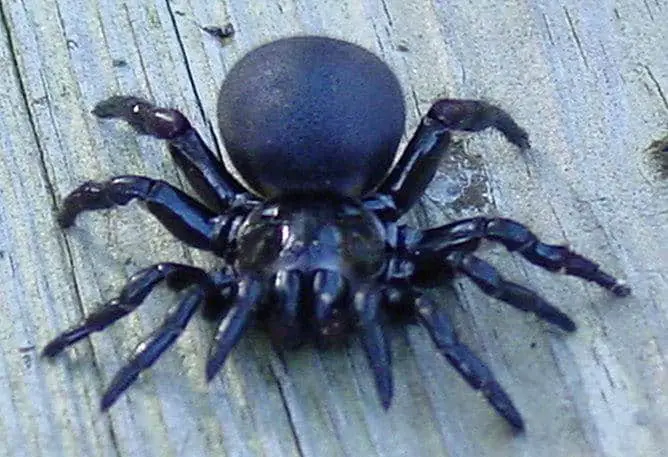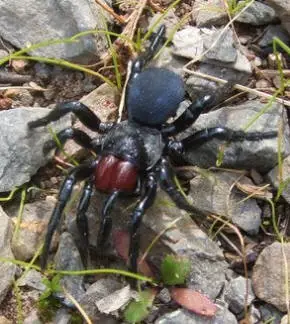The common name of the Mouse Spider is derived from the mistaken belief that this spider excavates a deep mouse-like burrow. Mouse Spiders belong to the family Actinopodidae, which consists of one genus – Missulena – and eight described species which include the Trapdoor spider family.
The Mouse Spider is a member of the Trapdoor family. Trapdoor spiders include the Funnel-web, Mouse, Whistling, and Curtain-web spiders; they are distinguished by the stocky body, long leg-like palps, and two knee-like lobes to which the fangs join (chelicerae) in front. Most live in burrows with or without trapdoors in the ground, but some live in trees. Trapdoor spiders have powerful chelicerae and four pale patches (the book-lungs) under the abdomen. The correct identification of Trapdoor spiders is often quite complicated.


The male Red Headed Mouse spider (pictured) has a bright red head and a blue abdomen. The Mouse Spider lives all over Australia but not in Tasmania. It lives in arid conditions as well as rainforests and bushlands. The home of the Mouse Spider is a burrow, oval shaped, of moderate depth and straight down. Female spiders spends all their lives in the burrow. Male spiders wander in Spring to Autumn. The burrow may be plastered with mud and digestive juices then lined with silk. They also live in other parts of the world like the USA.
Table of Contents
Habitat and Distribution:
Eastern Mouse Spiders are found in east coastal and highland regions of Australia. Red-headed Mouse Spiders are found across the continent mainly west of the Great Dividing Range. Like the trap-door spiders, the mouse spider lives in burrows in the ground, often in banks of rivers, creeks and other waterways, and is sometimes found in suburban gardens. The burrows are built with double or single trapdoors and the entrance is oval-shaped.
The burrow can extend for a depth of about 30cm – which is unusually deep for a spider, but not as deep as previously claimed for this species. The females tend to remain in or near their burrows throughout their life, and are sluggish spiders that are rarely aggressive. However M. occatoria females have been found to produce copious amounts of highly toxic venom, which is potentially as dangerous as that of the Sydney Funnel-web Spider. A male M. bradleyi caused a serious envenomation in a child in the Brisbane region. Males wander during early winter, especially after rain. They will assume a threatening posture if disturbed.
Prey:
Insects are the main prey of Mouse Spiders but their diet could possibly include small vertebrates and other spiders. Predators of the Mouse Spider include parasitic wasps, bandicoots, scorpions and centipedes.
Identification:
These spiders are squat animals 1-3cm long (Missulena bradleyi: 2 cm (female), 1.5cm (male); Missulena occatoria 2.5cm (female), 1.5cm (male)). They have a glossy carapace and their head area is high and broad with very large, bulbous jaws. Mouse spiders’ eyes are widespread across the front of their head. The spinnerets, at the back of the abdomen, are short and blunt. Females are black overall and are larger than the males, especially in the Red-headed Mouse Spider. Male Eastern Mouse Spiders are black with a bluish white patch on the front of the abdomen. Male Red-headed Mouse Spiders have a red head and jaws, and a gunmetal blue abdomen. Female Red-headed Mouse Spiders are dark brown to black, and the jaws are sometimes red-tinged, but they are very different in overall size and appearance, which led to confusion when the species was first being described. Spiders commonly mistaken for Mouse Spiders include: Trapdoor Spiders and Funnel-web.
Spiders Habits, Mating and Reproduction:
Males reach sexual maturity at about four years. They leave their shallow burrows during the breeding season to find a mate. They are unusual in that their wandering behaviour occurs during the day, unlike other mygalomorph spiders, whose males are night wanderers. Mating usually takes place within the female’s burrow. The female lays 60 or more eggs within an egg sac that she places into a brood chamber off the main shaft of her burrow. The spiderlings hatch from the egg sac over summer and remain with the mother into autumn when dispersal occurs. The spiderlings of the Red-headed Mouse Spider disperse by ballooning, a technique that is rare in mygalomorphs. This explains the relatively wide distribution of Red-headed Mouse Spiders compared to other mygalomorph species, including the Eastern Mouse Spider, which probably disperses on the ground.
Toxicity:
Mouse Spider venom may be very toxic, but only one serious envenomation has been recorded. Other bites have occurred causing minor effects. Funnel-web spider antivenom has proved effective in the one confirmed case.
First Aid:
Until more toxicity data is available it is prudent to treat as for Funnel-web spider bite, especially if the victim is a child. Apply a pressure bandage over the bitten area as high up the limb as possible. Immobilise the victim. Collect spider for positive identification. Do not wash venom off the skin, as retained venom will assist identification.
Information: Australian Museum
Click here for more photos of Mouse Spiders.
Information and pictures were taken from children’s projects and where credited to that child does not claim to be original information. Where possible, permission to reproduce has been sought. Any infringement of copyright is purely unintentional.
